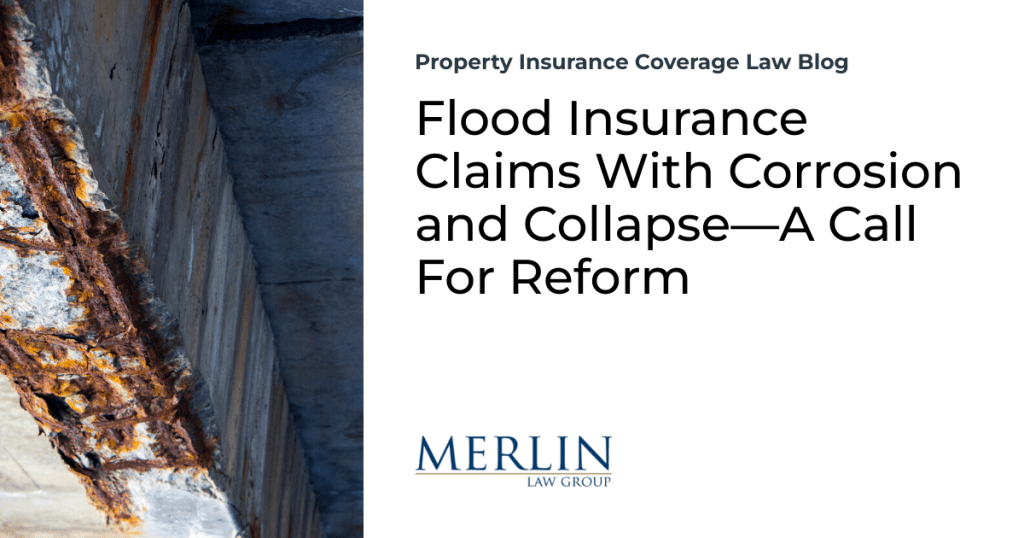Flood Insurance Claims With Corrosion and Collapse—A Call For Reform

The post, Collapse From Storm Surge—Will National Flood Pay These Claims? led to a number of questions on whether these cases can be won. They can be, but it is not easy. These federal flood claims are exacting from a technical fact and legal standpoint.
An example of a case—in which our firm did not represent the policyholder—shows many of the issues common to these scour and erosion cases following a storm surge.1 Federal flood trials are not jury trials. The federal judge makes the factual findings and applies the law. In this example, the federal judge found that much of the loss was the result of long-term corrosion not caused by the storm surge:
Upon consideration of the evidence, the Court finds Benton’s expert opinion more credible and helpful than that of Calitu or Gulati. As to the damage to the Piles, Benton generally provided specific, compelling testimony that aligned with the testimony of Bernardin. Bernardin testified that prior to Hurricane Irma, Plaintiffs maintenance personnel filled any cracks in the Columns or Beam Assembly with ‘material . . . so that the paint job look[ed] nice.’ However, Bernardin testified that he did not know what material or process his personnel used to fill the cracks.
Bernardin then testified that after the hurricane, cracks were visible. Benton testified that if cracks are not properly repaired by removing the damaged concrete, treating and coating the rebar, and patching the concrete, the result will be more cracking in the future. He testified that because Bernardin did not know the process or material used to repair the cracks prior to Hurricane Irma, he did not know whether the cracks were properly repaired. Based on these facts, Benton testified that cracks were likely cosmetically hidden prior to Hurricane Irma and caused by corroding rebar, not by damage to the Piles.
… the Court finds Benton’s testimony and reports persuasive and finds that (1) the foundation system performed as designed and the Piles did not suffer damage from flood; (2) the cracks in the Columns and Beam Assembly were the result of corroding rebar; and (3) the damage to the stucco on the Beam Assembly was not from flood but there was damage to the stucco on the Columns that was from flood.
Expert testimony is extremely important. I suggest that prior corrosion should have been admitted and that a higher actual cash value should have been advocated as wear and tear rather than claim it was all the result of the current flood.
The court made the following legal finding:
Weighing the testimony and evidence presented, the Court finds that Plaintiff failed to meet its burden to demonstrate that the Piles suffered ‘direct physical loss by or from flood,’ SFIP art. I, and are thus a covered loss under the SFIP. Rather, as set forth in the above Findings of Fact, the Court finds that the Property’s Piles were not damaged as a result of flood in light of the testimony and evidence showing (1) that there was an absence of flexural cracks in the Columns and Beam Assembly; and (2) that the horizontal cracks in the Columns and Beam Assembly likely predated Hurricane Irma and resulted from corroding rebar, which may have been the product of improper repair of cracks. Further, as set forth in the Findings of Fact, the Court finds Calitu’s opinions not credible because of the litany of flaws in his methodology. Finally, Calitu and Gulati’s general opinions and unsubstantiated conclusions and critiques were unpersuasive. Therefore, Plaintiff did not satisfy its burden to show that the Piles sustained damage from flood.
The policyholder has to prove the flood caused the damage. This, again, takes a very detailed expert opinion. The court simply believed the other version.
The policyholder also has to prove the damages caused only by the direct action of the flood:
Next, the Court turns to determining whether Plaintiff has satisfied its burden to prove the specific, additional amount owed under the SFIP for the repairs to the Piles, concrete Columns and Beam Assembly, and stucco on the exterior of the Property. As an initial matter and as set forth above, the Calitu Estimate is unreliable in light of the testimony and evidence that (1) it includes repairs to the Property that Calitu acknowledges are not covered under the SFIP; (2) it does not follow the definition of ACV, despite Calitu claiming that it constitutes ACV; and (3) it includes erroneous rates for overhead and profit for a general contractor to oversee the repairs. See supra Section I.B.ii; see also Mahood, 174 F. Supp. 2d at 292 (finding that an estimate “cannot be relied on for an accurate evaluation of the covered loss” because it included items not covered by the policy); Slater, 2015 U.S. Dist. LEXIS 36824, 2015 WL 1310984, discrediting an estimate because the estimate and testimony failed to address the question of whether the listed repairs were covered under the SFIP). Further, at trial, Plaintiff presented little evidence on the Calitu Estimate other than admitting the estimate into evidence. Therefore, the scope of these repairs and how Calitu arrived at these estimates remains unclear.
Sometimes, the National Flood Insurance lawyers, in their zeal to win, advocate for horrible law, which again invites reform. Those lawyers persuaded the learned federal judge into the following most bizarre statement of the insurance law, which I respectfully disagree with:
[T]he compaction grouting and underpinning were not present at the time of Hurricane Irma. Therefore, the estimates to repair these items would not be considered ACVs under the SFIP…because an ACV covers the cost to replace an insured item, not repair it. See SFIP art. II(B)(2) (defining actual cost value as ‘[t]he cost to replace an insured item of property at the time of loss, less the value of its physical depreciation’).
What? Read it again. It is simply wrong. Actual Cash Value (ACV) is limited by the replacement cost, but “actual cash value” is not the “cost to replace,” as this jurist stated. If the repair to like kind and quality can be done for less than replacement less deprecation, the repair value should be considered. Often, a repair is not back to like kind and quality but something else, but the cost to repair should be considered for actual cash value, especially if it is less than the cost to replace.
We need reform because the National Flood Administrators apparently only care about looking good when they make poor adjustment decisions, protecting their jobs, and not protecting the integrity of the program and the people it is supposed to serve. If it were otherwise, they would never let their counsel make such an argument that a judge erroneously agrees. I am not saying that the result is wrong, but this reasoning is very wrong when it comes to hundreds of years of insurance coverage law about the difference between replacement cost coverage and actual cash value coverage.
I am certain those federal flood administrators hate a knowledgeable critic pointing out how they are failing constituents and ruining the lives of people the flood insurance program was supposed to protect. But they need to be called out. Congress needs to step in and do something—so does the President, since the people that operate FEMA report to him.
Federal flood claims are almost a “heads I win, tails you lose” scenario because of how federal law is applied. The “win at all costs” its counsel is allowed to make has led this flood program astray. These are tough cases, with no sanctions or penalties for bad faith or wrongful denial. Federal court costs are ridiculously expensive because of the federal court procedural requirements. How can anybody bring a dispute for less than $75,000 and pay an attorney and experts to do all of this and gain any recovery? Justice with the federal flood program is often a dream, and reform is needed.
This is not just me calling for reform of the National Flood Program. In a previous post, Are Some Managers Running the National Flood Insurance Program Corrupt?, I noted that others have filed legislation to do so. Florida’s Congressional delegation should follow up with hearings and join their colleagues from other states making this program one our country can be proud of rather than what it has become for ordinary flood policyholders suffering from a second adjustment loss after the flood devasted them.
Thought For The Day
Our leaders should certainly engage passionate advocacy of needed reforms, and equally strong criticism of policies they believe are destructive to America. But, from the school boards to the White House, let’s elect more candidates who are committed to constructive dialogue and reasonable compromises.
—Martin Luther King III
__________________________________________________________
1 Islamorada Leisure Props. v. Bankers Ins. Grp., No. 4:18-cv-10186, 2020 U.S. Dist. LEXIS 44422 (S.D. Fla. Mar. 11, 2022).




